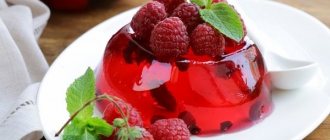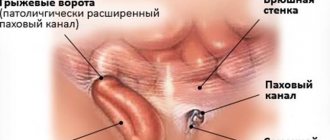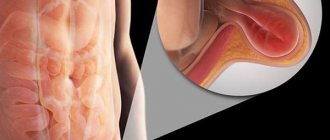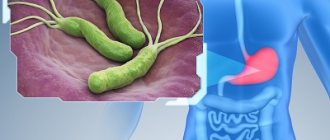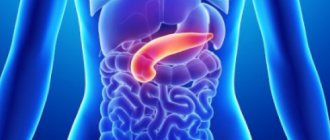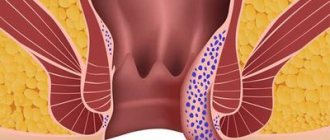One of the important elements of treatment is nutrition for gastric hernia. With the help of a dietary diet, it is possible to narrow the hernial opening of the diaphragm, improve metabolic processes, and relieve the patient from pain. If a person does not follow all the doctor’s recommendations regarding the menu, the disease can cause a number of serious complications.
Principles of nutrition
A diet for a gastric hernia requires the patient to comply with the following rules:
- Avoid foods that cause bloating.
- Submit food to heat treatment.
- Eat meals at least 5 times a day in small portions.
- Avoid overeating.
- Take your last meal 4 hours before going to bed.
- Chew foods thoroughly.
- Avoid drinking alcoholic beverages, soda, and sour juices.
- Lose excess weight, if any.
- Quit smoking.
Causes and manifestations of hiatal hernia
The hiatal hernia is a pouch-like protrusion of the esophagus or part of the stomach near the esophageal opening of the diaphragm, which is a muscular partition between the chest and abdominal cavity. The development of such a protrusion is a consequence of a decrease in the tone of the muscles of the diaphragm, as well as an expansion of its esophageal opening. There are several etiological (causal) factors contributing to the formation of a hernia, these include:
- Increased intrathoracic pressure due to systematic heavy physical work, prolonged cough, pregnancy, childbirth in women, chronic constipation.
- Congenital decrease in elasticity, strength of muscle fibers and connective tissue of the diaphragm.
- Violation of muscle innervation with a subsequent decrease in their tone.
- Poor nutrition, especially associated with overeating at night, abuse of alcoholic beverages, fried, fatty foods.
The impact of such etiological factors is cumulative, so hiatal hernia develops mainly in older people.
A hiatal hernia may not manifest itself for a long time. As the protrusion increases, pain appears behind the sternum or epigastrium (upper abdomen, area of projection of the stomach), almost constant heartburn, and worsening swallowing. To accurately identify a hernia, additional instrumental methods for its visualization are used - ultrasound, radiography of the esophagus with a contrast agent.
Authorized Products
If a person is diagnosed with a gastric hernia, he can eat the following foods:
Bananas are allowed to be eaten for this disease.
- bananas;
- chopped apples;
- green beans;
- carrot;
- low-fat fermented milk products;
- eggs (preferably without yolk);
- lean types of meat and fish;
- potato;
- cereals
Drinks good for the spine
Honey is good for the spine. It can be consumed neat or added to drinks as a sweetener. It is useful to make freshly squeezed juice from vegetables. It is advisable to make herbal infusions. You can brew ready-made mixtures or create your own recipe based on:
- rosehip, which normalizes metabolism and accelerates the removal of toxins;
- sage, which prevents the development of degenerative changes in the intervertebral discs;
- mountaineer (buckwheat), which has an analgesic effect;
- chamomile, which neutralizes inflammatory processes;
- birch, which has a calming and relaxing effect.
It's worth drinking plant-based milk. It is made from nuts, cereals and legumes. The most popular are coconut, oat, soy or almond milk. These drinks contain a lot of vitamins and microelements. They are easily and quickly digested.
Forbidden food
Garlic should be excluded from your diet.
If you have a hernia, you will need to exclude the following products from the menu:
- sour fruits;
- coffee;
- ice cream;
- chocolate-containing treats;
- spicy, fatty, fried foods;
- marinades and pickles;
- vinegar;
- garlic;
- mint;
- tomatoes;
- carbonated drinks;
- vegetable and butter oils;
- nuts;
- products containing coarse fiber;
- chips.
Summary
When drawing up a diet for nutrition in cases of spinal hernia, doctors at our clinic take into account the patient’s body weight and preferences. They certainly clarify the lifestyle and specifics of a person’s activities so that the diet does not interfere with the usual way of life. When compiling the menu, they focus on fresh vegetables, fruits and other foods rich in collagen.
If for one reason or another it is not possible to provide a complete diet or some of the nutrients are not absorbed, doctors advise taking special vitamin complexes. For example, these may be preparations containing vitamin D. In some regions they should be taken seasonally when there is not enough natural light. All drugs are selected individually.
Sample menu
The diet that the patient will need to follow is determined by the treating specialist. At the same time, it takes into account the individual characteristics of the human body. Thanks to this, it is possible to achieve the most positive results in a short period. The patient should know what diet to follow and healthy recipes. Nutritionists have developed a sample menu for 3 days.
First day
Oatmeal with banana is a delicious and healthy breakfast.
- Breakfast: oatmeal with banana;
- green tea.
- fruit salad from permitted fruits;
- vegetable soup;
- biscuits;
- hake fillet baked in the oven;
Second day
On the second day, you can start your morning meal with a steamed omelet.
- Breakfast: steam omelette;
- grain bread with processed cheese;
- weak tea.
- cottage cheese casserole with honey;
- lean borscht;
- carrot and beet salad seasoned with low-fat sour cream;
- carrot cutlets;
The third day
Buckwheat porridge with milk will perfectly complement the diet of the third day.
- Breakfast: buckwheat porridge cooked in milk;
- steamed turkey cutlets;
- bell pepper;
- Black tea.
- low-fat cottage cheese with jam;
- cauliflower soup;
- fruit salad;
- cheesecakes with low-fat sour cream;
Terms of rehabilitation
A rehabilitation program is drawn up immediately after the completion of surgery. Patients should take their first steps within 1-2 days. The rehabilitation period is from 4 months. It depends on:
- Type of operation. After a minimally invasive intervention, rehabilitation will take a month, while after a discectomy it will take at least six months.
- Patient's age. Rehabilitation for older people takes longer.
- Health. Rehabilitation will be delayed if there is a history of chronic diseases (diabetes mellitus).
- Weights. Obese people take longer to recover.
- The nature of the vertebral hernia. This is its size, how long ago the disease was, what difficulties it caused.
Delicious recipes
You can cook your favorite dishes by excluding prohibited foods from the recipe.
Eating during a gastric hernia can be not only healthy, but also tasty. The diet allows you to consume a fairly extensive list of foods. At the same time, a person can include even familiar dishes in their diet by excluding just a few ingredients from their recipes. However, before adding new products to the menu, it is important to consult with a specialized physician.
Healthy salad "Olivier"
You will need to take chicken fillet, carrots, potatoes, green peas and natural yogurt that does not contain fruit additives. First of all, the chicken is stripped of membranes and sent to cook until cooked. Vegetables are also boiled, peeling them after cooking. The finished ingredients are cut into small cubes and mixed thoroughly. Salt it a little, then add natural yoghurt. The salad is mixed and served with finely chopped parsley.
Cutlets with egg
You will need veal, bread, low-fat milk, eggs. First of all, the bun is soaked in milk, after which they begin to prepare the minced meat in a meat grinder. Then the already soaked bread is mixed with chopped meat and a raw egg is added. The second is sent to the stove to cook. When it is ready, peel it and cut it into 2 parts. Each of them is wrapped in minced meat, formed into a cutlet and sent to a non-stick frying pan, which is preheated well. It is important that it is forbidden to add vegetable oil. At this time, turn on the oven. When the cutlets are fried on both sides, they are placed in a baking dish and placed in the oven for 15-20 minutes at 180 degrees.
What happens if you don't undergo rehabilitation?
If you ignore the rehabilitation period, the tissues will not heal properly, which will reduce the effectiveness of the hernia surgery. Muscles and ligaments will remain undeveloped, which will have a bad effect on flexibility and the ability to withstand stress. The result is a recurrence of the vertebral hernia, the return of discomfort.
Each type of intervertebral hernia has serious complications, so you should not delay treatment.
See how easy it is to get rid of a hernia in 10 sessions
Approach to rehabilitation at Paramita
At the Moscow Paramita clinic, rehabilitation after surgery to remove a spinal hernia takes place in stages. A detailed recovery program is established based on:
- medical history;
- complexity of operations;
- concomitant diseases;
- age;
- gender;
- physical capabilities;
- data from laboratory tests, x-rays, MRI, etc.
After removal of a hernia, our doctors work with each patient according to an individual program. In the treatment of hernia, we use both Western and Eastern methods - physiotherapy, massage, hirudotherapy, acupuncture, etc.
The center has modern equipment at its disposal, which helps to quickly recover after surgery. Doctors closely monitor the progress of rehabilitation and adjust the program in a timely manner. We are always in touch with our patients and respond to all requests instantly.
We use non-surgical hernia treatment techniques
Read more about our unique technique
What does rehabilitation include?
High-quality rehabilitation is a set of measures, each of which is aimed at improving the patient’s health. They are selected individually. To achieve the desired effect, all actions must be carried out under the strict supervision of a physician. The doctor's recommendations must be followed strictly.
Drug therapy
To relieve pain and swelling after surgery in the cervical, lumbar, and thoracic regions, the doctor prescribes:
- Analgesics
(Analgin, Lidocaine, Ketotifen) - relieve pain or reduce its manifestations. - Antibiotics
(Penicillin, Cefazolin, Vancomycin) are needed to prevent post-surgical infections. - NSAIDs
(Diclofenac, Diclak, Ketorol) - non-steroidal anti-inflammatory drugs prevent and relieve inflammation, swelling, pain. - Muscle relaxants
(Baclofen, Tolperisone, Tizanidine) - relax stiff muscles. - Chondroprotectors
(Teraflex, Artra) – strengthen bones and cartilage. - Vitamin-mineral complexes
– trigger metabolic processes, which promotes tissue healing.
Drugs prescribed during the rehabilitation period after hernia surgery
The course of drug therapy is selected by the doctor. You cannot independently reduce or increase the dosage, or shorten the course of rehabilitation after removal of a hernia. As healing progresses, the need for antibiotics, NSAIDs, and analgesics disappears. On the 10th day after removal of the hernia, antibiotics are discontinued if there are no bacterial complications.
Analgesics and NSAIDs are taken until the pain disappears. Chondoprotectors and vitamin complexes that strengthen bones and joints can be used in courses for the rest of your life.
Exercise therapy and gymnastics
The goal of exercise therapy is to restore lost functions of the spine. Exercises strengthen the back muscles, make the ligaments more flexible, without injuring or overloading them. They improve blood flow, and with it the supply of nutrients to the damaged disc, which accelerates tissue regeneration.
To achieve the desired effect, a set of exercises must be selected by the doctor taking into account the age, health, weight, and physical capabilities of the patient. Any attempts to independently adjust exercise therapy, without consultation with a rehabilitation specialist, can provoke an exacerbation of the hernia.
When performing exercises, remember these rules:
- Do not increase the load suddenly.
- Always wear a brace or collar during training.
- If an exercise causes pain, stop immediately or reduce the load. You are not ready for it yet. Contact your doctor for exercise correction.
- Do not do exercises that are prohibited at this stage of rehabilitation after surgery for a herniated disc.
- Avoid active, sudden actions. Swinging legs, jumping, strong bending, twisting exercises, and pull-ups on the horizontal bar are prohibited. Also, you should not make sharp turns of the body to the right or left.
- At the initial stage, the use of barbells, dumbbells, and any power loads is prohibited. If the doctor has approved push-ups, the exercise should first be done from the wall, and only then gradually move on to the classic version.
- Walk every day, preferably in a park or forest. Duration of walks is 30-60 minutes, rest periodically.
Best exercises
Immediately after surgery to remove a herniated disc, the doctor prescribes a gentle complex of exercise therapy. Exercises are done from a supine position:
- Rotation of hands and feet in a circle.
- Move your feet down/up.
- Bend your legs at the knee, bend your arms at the elbow.
- Pulling the right, then the left leg towards the stomach.
Over time, the complex becomes more complicated. The doctor gives more complex stretching exercises to strengthen muscle tissue. Depending on the situation, each action must be done from 4 to 10 (no more) times:
- Lying on your left side, lift your left leg straight. Bend your left elbow and place your hand behind your head. Then change the side.
- Lying on your back, lift your pelvis off the surface.
- Lying on your back, tuck your chin toward your chest.
What types of intervertebral hernias are most difficult to treat?
4 stages of treatment for intervertebral hernia
What to give up
For a healthy diet if you have a lumbar hernia, you should limit your consumption of flour and confectionery products as much as possible. But this does not mean that you need to completely abandon them. Once a week in the morning or for an afternoon snack, you can allow yourself to eat some cookies, a couple of buns or sweets.
Spicy and fatty foods must be strictly excluded from the diet for the entire rehabilitation period. You should also give up alcohol, as it weakens the body and negatively affects blood vessels, and some alcoholic drinks, such as beer, contribute to weight gain. Only a glass of dry red wine is allowed at lunchtime or in the evening.
The menu for lumbar intervertebral hernia should also not include:
- sour foods;
- smoked meats;
- jelly;
- mayonnaise and ketchup;
- marinades;
- canned food;
- semi-finished products;
- sugar and salt in excessive quantities;
- ice cream;
- caffeinated drinks;
- White bread;
- fast food;
- carbonated drinks;
- White rice;
- margarine.
You shouldn’t limit yourself too strictly, since with constant breakdowns and bad mood, the treatment also loses its effectiveness. If these products and food components cannot be removed completely, their consumption should be minimized. The fact is that many of them can worsen degenerative processes in cartilage and tissues, and wash away beneficial salts and trace elements from bones.
It is especially important to monitor your intake of salty foods. You need to consider how much salt is in the ready-made products you buy. For example, sausages, nuts and cheeses are sold already quite salty. With an excess of salts, the cartilage tissue of the vertebral discs lacks internal moisture, so their fragility increases.
What vitamins are needed for a hernia?
One of the most important tasks is to saturate the body with vitamins, which accelerate regeneration processes in cartilage and bone tissues. Experts name several substances that must be contained in selected food products.
- B vitamins. For people suffering from herniated discs, pyridoxine and thiamine are especially useful. These compounds serve as a kind of natural pain reliever. Thanks to their presence, muscle spasms are eliminated, and the nerve processes are relieved of pressure. Consequently, the patient will not feel pain as acutely as before. The most accessible sources of B vitamins are cereals, bread, meat, cottage cheese, peas and beans.
- Vitamin A. It is this compound that plays a key role in the regeneration of any damaged tissue. The substance is found in liver, eggs, carrots. It should be remembered that this is a fat-soluble vitamin, so it must be taken with appropriate supplements, for example, sunflower or corn oil.
- Vitamins C and E. Both compounds are part of the antioxidant group. Such substances are useful in that they protect cells from early death. In addition, these vitamins have been proven to reduce stress levels, which often increase due to the unpleasant symptoms of a herniated disc. Vitamin C is found in large quantities in citrus fruits, kiwi, strawberries, rose hips, and sea buckthorn. To get your dose of vitamin E, you need to eat green leafy vegetables and drink milk.
- Vitamin D. A substance that cannot be avoided in the treatment of any pathology of the musculoskeletal system. The connection does not affect cartilage tissue and intervertebral discs, but helps restore the damaged spine and strengthen it. Sources of vitamin D for the human body are fish, beef and offal. The same substance is synthesized naturally under the influence of UV rays.
Vitamins accelerate regeneration processes in cartilage and bone tissues
On a note! Doctors recommend saturating your diet with foods that contain healthy vitamins. This will help you get rid of pain faster and relieve the exacerbation of pathology.

